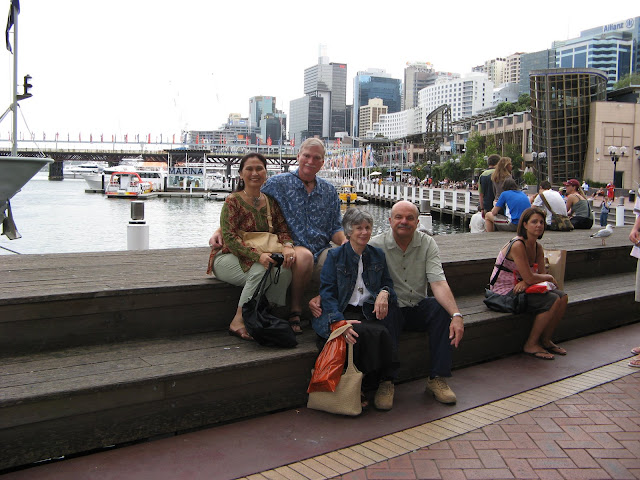
Our friend, Doug Noble, who has visited 100 countries, once said that one of his favorite places is Sydney. I will admit that I had low expectations of Australia. I knew the history of the place, how it had been populated by English convicts in the late 1700s. And I was quite fascinated by a documentary (after a book of the same title), The Floating Brothel, about the women who were sent to Australia in the late 1700s - petty thieves, prostitutes, etc. and how along the way, they had turned the ship they were on, into a floating brothel. When they arrived Australia, a number of them got off the ship carrying babies in their arms. What was most fascinating was that many of these women went on to be respectable citizens, and in fact were ancestors to numerous Aussies.
Why I did not expect much from Australia was that I thought it'd be pretty much like any other English-occupied place. There's a sameness to them, really, the architecture, the culture. I have arrived at the conclusion that the English were/are master colonizers - they occupy a place and bring in their women so that families can settle the place. This happened in the U.S., South Africa, even remote Falklands. So I figured Australia would be something like England or Canada, with Churches of Christ and orderly streets, and pubs, and cars going down the "wrong side" of the road.
Well, Sydney has surprised me, and I'm quite crazy about it. I can't rattle off my reasons for liking the place, because a lot of it has to do with the feeling of the place. First, it is a city, but unlike New York, or London, or Paris, it isn't crowded nor frenetic. It's a relatively calm city, and yet the high-rises are there. Traffic isn't awful, and where we are - Hyde Park Inn on Elizabeth Street - we can walk to Darling Harbour, St. Mary's Cathedral, even all the way to Circle Quay. The city is clean, orderly, and yet people, probably mostly tourists like me, look laid back. There are quite a lot of immigrants: South Asians, Koreans, Filipinos, Europeans whose accents I couldn't place, probably Greeks. So, the place has a vibrancy and energy that's interesting and not boring.
The gardens are lovely, streets clean, standard of living clearly high, and - here's the quirky part - there are bats that come swooping down the city at dusk. They roost in the botanical gardens, and when the sun is down, fly all over the city. From our balcony, looking at the tops of the trees of the park in front, and the tall buildings across the way, one could imagine the place is Gotham City - it's a trip!

Yesterday, my classmate Rose Cuisia Franco, who has lived in Australia for 14 years, picked me up and we went to an antique shop. Then we went to the Rocks, an area developed by convicts, and which in the 1800s was the main drag in Sydney. It's been gentrified and now there are shops and restaurants, and it has an excellent view of the famous Sydney Opera House, and the bridge.

Today, the group of us (Lauren, Mike and Linda Ross) took the ferry to Manly Island, had lunch in the square fronting the ferry terminal, and listened to the Police band, which was quite good. They played mostly swing music, but also had some modern ones. Walked around the island, and got back on the ferry, did another round of the Rocks (my companions hadn't seen it yesterday), and hopped on the metro for a five minute trip back to our hotel.
Later that evening it rained and we watched it while eating pizza and drinking lovely Shiraz Aussie wine. We also watched the bats.
I'm quite charmed by Sydney.
 This is Vegemite, that Australians love; they spread it on toast, on top of butter; it tastes like Brewer's yeast with soy sauce.
This is Vegemite, that Australians love; they spread it on toast, on top of butter; it tastes like Brewer's yeast with soy sauce.Top picture shows l-r: Rose Franco, Mike and Linda Ross, and Lauren
All for now,
Cecilia Brainard
tags: travel, tourism, Australia, Sydney, Vegemite, Cecilia Brainard






































